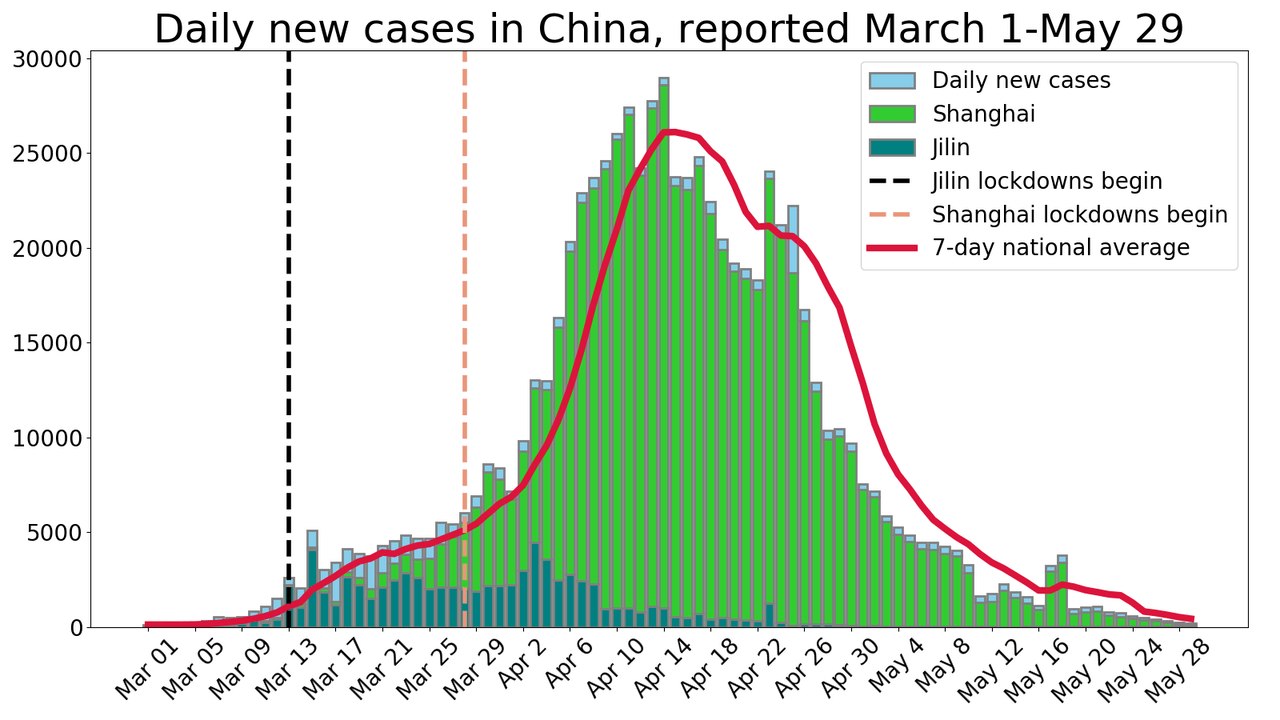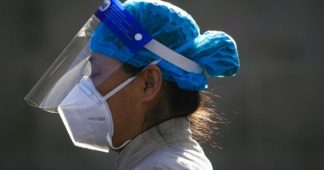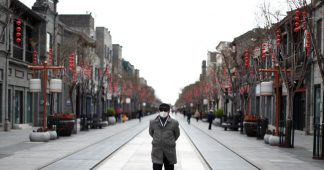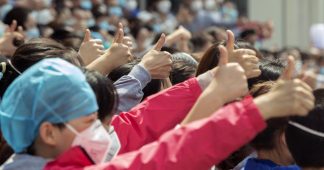By Patrick Martin, Benjamin Mateus
Jun 2, 2022
China’s largest city, Shanghai, largely reopened Wednesday morning after a two-month lockdown that successfully beat back an outbreak of the virulent Omicron BA.2 subvariant of COVID-19. The event was a triumph of public health mobilization, as the outbreak, which reached a peak of almost 30,000 infections per day in mid-April, took the lives of fewer than 600 people, mostly elderly and unvaccinated.
During those two months, most offices, factories, and other workplaces were closed, although production continued in certain key industries with workers bunking down in the plants and rarely going out in a process known as a closed-loop system. Schools shifted to online education, mass transit was virtually empty of passengers, and the few stores that remained open could provide goods only on a curbside take-out basis. The city itself was shut off from the rest of the country, with visitors allowed to enter only after a 14-day period of quarantine.
For the most part, residents remained in their homes, with the internet their principal connection to the outside world. Food deliveries and supplies of other necessities were organized through the country’s extensive networks of housing blocks and neighborhood committees, later supplanted by the government.
On Wednesday, nearly one million passengers rode the subways carrying passengers to work as stores and malls are rapidly opening for brisk business. Close to 330,000 cars were traversing the city streets. Shanghai’s landmark Yuyuan Garden Malls reopened operating under normal hours. Supermarkets have opened their doors to local customers. Even Shanghai’s top automaker SAIC Motor reported that production is at 80 percent of capacity.
More than 22.5 million residents (90 percent of Shanghai’s population) now live in low-risk districts, meaning that these sections have been declared free of infection for more than two weeks. Rigorous bi-weekly COVID PCR testing continues, as the public health apparatus remains on full alert. As one resident speaking with South China Morning Post noted, “The sirens and the noise from vehicles are back to pre-lockdown levels, but this is the Shanghai we know, good or bad.”
It is impossible to overstate the political significance of the successful fight against COVID in Shanghai. There can no longer be any debate about what policies should be pursued to protect the world’s population from this deadly infection.
As the second of Marx’s deservedly famous Theses on Feuerbach declares: “The question whether objective truth can be attributed to human thinking is not a question of theory but a practical question. In practice man must prove the truth, that is, the reality and power, the this-sidedness of his thinking.”
The example of China proves that zero-COVID is effective, even against the most infectious variant of coronavirus to emerge so far. The outbreak in Shanghai apparently had two causes: infections brought from outside China, inevitable given the city’s role in the world economy, and lax enforcement of the zero-COVID policy by officials in the city, which was overturned by Beijing after the number of infections began to skyrocket. Even so, the worst day of the pandemic in China, in mid-April, saw the seven-day average in COVID infections reach 26,109. During that same period, the United States hit a low of 27,000 daily new infections, after the waning of the Omicron spike and before the emergence of the next wave, fueled by the BA.2 subvariant. Now the daily infections in the US are pushing 110,000 again, while daily community infections in all of China were 68 yesterday. In Shanghai there were only 11 COVID cases. The last COVID death occurred six days ago.
Even so, the worst day of the pandemic in China, in mid-April, saw the seven-day average in COVID infections reach 26,109. During that same period, the United States hit a low of 27,000 daily new infections, after the waning of the Omicron spike and before the emergence of the next wave, fueled by the BA.2 subvariant. Now the daily infections in the US are pushing 110,000 again, while daily community infections in all of China were 68 yesterday. In Shanghai there were only 11 COVID cases. The last COVID death occurred six days ago.
More broadly, in the course of the pandemic, life expectancy in China for the first time surpassed that in the United States. Despite the US being richer and with a more technically proficient medical infrastructure, the inequalities in access to health care, the deepening social crisis expressed in “deaths of despair” (opioid deaths, suicides, other drug and alcohol-related deaths) and above all, the loss of 1 million lives to a pandemic that was completely preventable, have led to an unprecedented decline in life expectancy, one of the benchmarks of the viability of any society.
By contrast China has limited the total COVID reported deaths to 5,226. And according to the WHO excess death report recently released, China saw negative 52,000 deaths. In other words, the efforts to address the pandemic also led to lives saved that would have otherwise been lost to other, non-COVID causes.
On a public health level, the efforts to contain the infection caused by a highly airborne pathogen such as Omicron in a city of 26 million inhabitants packed densely together is a remarkable tribute to the initiatives undertaken to eliminate the disease from the metropolis.
It pours cold water over the incessant claims by the bourgeois press that the population had to accept life with the virus and never-ending repeated infections, as well as the prospect of Long COVID if they were fortunate enough to survive the acute illness.
Indeed, the efforts in Shanghai deserve both praise and intense clinical study and assimilation. Given globalization and climate change, the opportunity for viruses to jump into human populations is predicted to burgeon. Not only is an international pandemic preparedness infrastructure of critical necessity, so is the comprehension of how to apply these complex pandemic measures to contain pathogens, as demonstrated in Shanghai. Dynamic zero-COVID is the essence of the containment for any disease that threatens human populations.
Yet, rather than applauding China’s success, the response by the American corporate media was decidedly negative, if not overtly hostile. The New York Times, after spending weeks portraying the lockdown as a futile effort by Chinese authorities to accomplish the impossible—beating back Omicron—through repressive and anti-democratic methods, was not about to concede that the policy pursued in Shanghai had been correct.
They depicted the people of Shanghai as though they had just suffered devastation from a hurricane or earthquake or were shell-shocked from a months-long military bombardment, breathing sighs of relief over the end of mass suffering, rather than celebrating a victory over a life-threatening virus.
Times reporters even found one Shanghai graduate student who told them, “I feel like that harm from the pandemic measures is worse than the harm of the virus itself.” The reporters were apparently tasked to find at least one person out of a billion in China to echo the words of Times columnist Thomas Friedman, who inaugurated the US campaign against lockdowns two years ago by warning “the cure can’t be worse than the disease.”
Not once has the official media of Wall Street discussed the economic disaster that would befall the globe had China allowed the “learn to live with the virus” policy to dictate its strategy. During the Omicron wave last winter, deaths soared outside China, as did worker absenteeism. Over a six-month period, China would have faced 1.6 million deaths, a collapse of its health care system, and a complete destabilization of society.
The corporate media response is driven entirely by the interests of Wall Street and American imperialism. They wanted China to suffer a collapse in the face of Omicron, both to bring to an end the policy of zero-COVID which constitutes a standing indictment of the indifference of the imperialist governments to mass death of their citizens, and to inflict a significant material blow against China, which Washington views as its greatest strategic threat.
The decent, humane response to the reopening of Shanghai would be twofold: to congratulate the Chinese people for an epic accomplishment; and to raise the issue, why are the United States, Germany, Britain, and all other countries incapable of carrying out such a life-saving campaign?
Because it does not pursue the zero-COVID policy, Hong Kong is facing a new wave of infections with the more contagious and pathogenic BA.4/5 subvariants of Omicron. South Africa underwent a fifth wave of infections despite having a nearly 100 percent population immunity. The White House has warned that the fall and winter could see 100 million new infections in the United States with rising casualties.
The WSWS has explained the necessity for a strategy of elimination. China, a country of 1.4 billion people has demonstrated that with initiative, even these highly contagious pathogens can be contained and eliminated. Yet, given the rest of the world’s complete disregard of the long-term threat posed by SARS-Cov-2, China will face even more pressures to abandon its defenses.
There is a profound political and strategic lesson: it is possible for a country to fight COVID, but it is not possible to eliminate the virus in a single country in isolation, because the world is an interconnected global society. The fight against the pandemic is inherently international in scope, and it requires the mobilization of the only class whose interests are not tied to the national state: the international working class.
As part of the struggle to develop the revolutionary political consciousness of the working class, the World Socialist Web Site launched a campaign last November for a Global Workers Inquest into the COVID-19 Pandemic. An examination of the experience of the Chinese working class in carrying out the zero-COVID policy is essential to the work of this inquest.
We remind our readers that publication of articles on our site does not mean that we agree with what is written. Our policy is to publish anything which we consider of interest, so as to assist our readers in forming their opinions. Sometimes we even publish articles with which we totally disagree, since we believe it is important for our readers to be informed on as wide a spectrum of views as possible.











